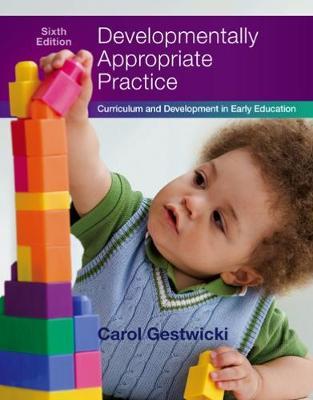Overview
Thoughtful and comprehensive, DEVELOPMENTALLY APPROPRIATE PRACTICE: CURRICULUM AND DEVELOPMENT IN EARLY EDUCATION, 6th Edition, is designed to meet the needs of new early childhood students as well as experienced teachers, professionals, and parents. It provides you with an overview of the concepts and theoretical foundations of appropriate practices in every developmental domain and discusses the practical implications for teachers and caregivers. The text reflects the NAEYC position statement on Developmentally Appropriate Practice and includes content on aligning early childhood teaching practices with national education standards, in addition to many interesting anecdotes, vignettes, interactive features, and applications to help you understand and apply the material. The text also shows you how to be effective no matter what curriculum model is used in your center, whether Reggio Emilia, Montessori, High Scope, Creative Curriculum, Bank Street, Waldorf, or any other.
Full Product Details
Author: Carol Gestwicki (Central Piedmont College)
Publisher: Cengage Learning, Inc
Imprint: Wadsworth Publishing Co Inc
Edition: 6th edition
Dimensions:
Width: 21.50cm
, Height: 27.40cm
, Length: 2.50cm
Weight: 1.065kg
ISBN: 9781305501027
ISBN 10: 1305501020
Pages: 496
Publication Date: 01 January 2016
Audience:
College/higher education
,
Tertiary & Higher Education
Format: Paperback
Publisher's Status: Active
Availability: Available To Order

We have confirmation that this item is in stock with the supplier. It will be ordered in for you and dispatched immediately.
Reviews
The text is an excellent resource in early childhood education. The volume is a must in developing developmentally appropriate curriculum! [This book is] practical and comprehensive with relevant research.
[This book is] practical and comprehensive with relevant research.
Author Information
Carol Gestwicki was an instructor in the early childhood education program at Central Piedmont Community College in Charlotte, North Carolina, for over 30 years. Her teaching responsibilities have included supervising students in classroom situations as they work with families. Earlier in her career, she worked with children and families in a variety of community agencies and schools in Toronto, New York, New Jersey, and Namibia (South West Africa).She received her MA from Drew University. She has been an active member of the NAEYC for many years, including making numerous presentations at state and national conferences. She has been a Fellow in the Early Childhood Leadership Development Project at the University of North Carolina at Chapel Hill, and she has been associated with the T.E.A.C.H. Model/Mentor program.Her other publications include more than two dozen articles about child development and family issues and scripts and design for 14 audiovisual instructional programs. She has three other books on topics in early education published by Delmar Learning: Developmentally Appropriate Practice: Curriculum and Development in Early Education, Fifth edition (2013); Essentials of Early Education (1997); and Authentic Childhood: Exploring Reggio Emilia in the Classroom (2002). Currently, she writes a regular column titled “Grandma Says” for Growing Child.



